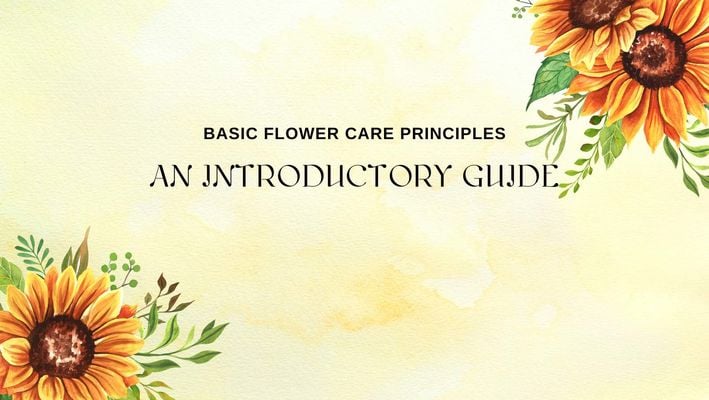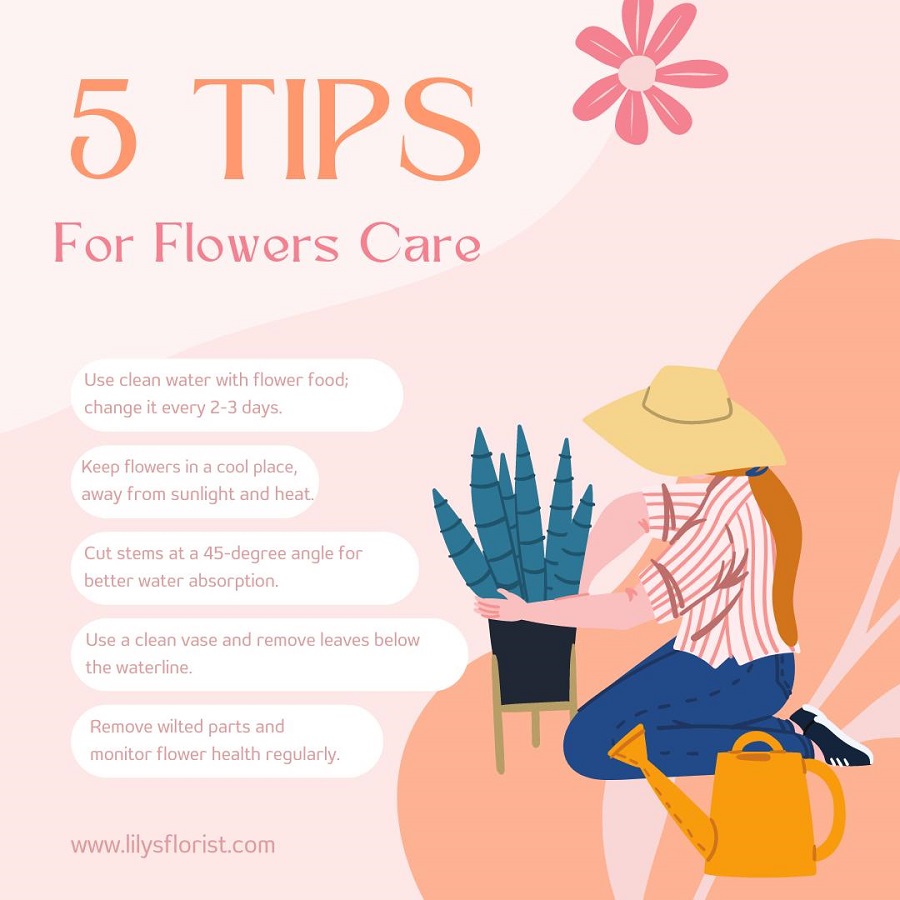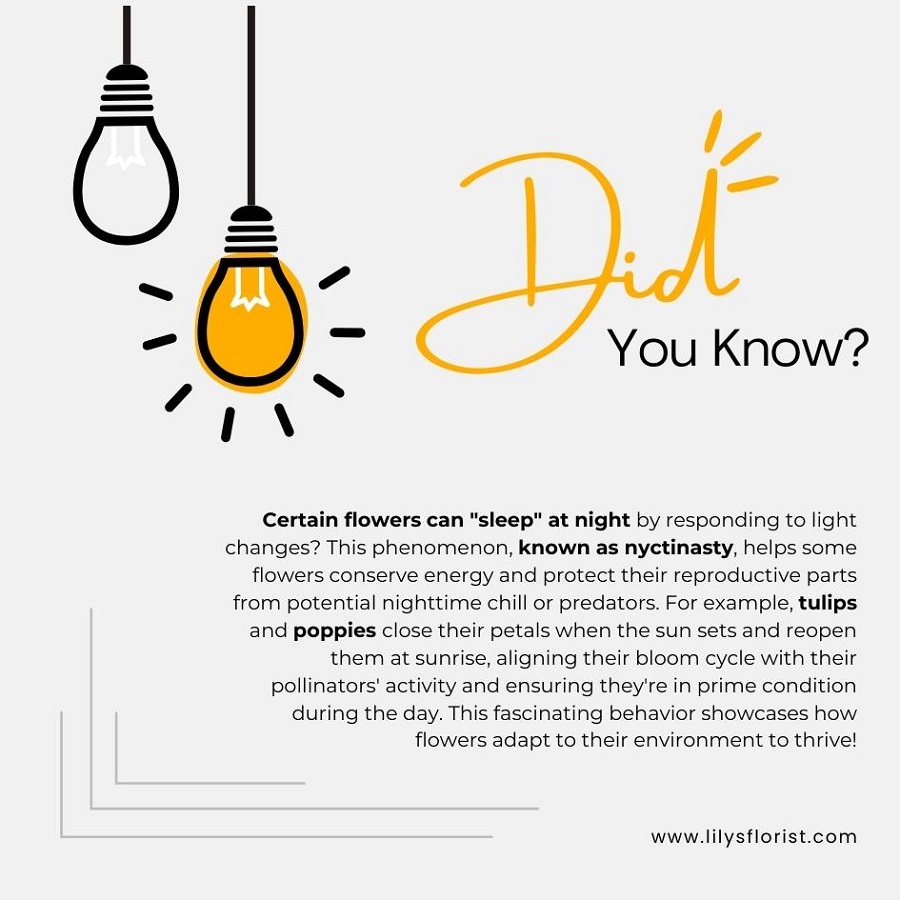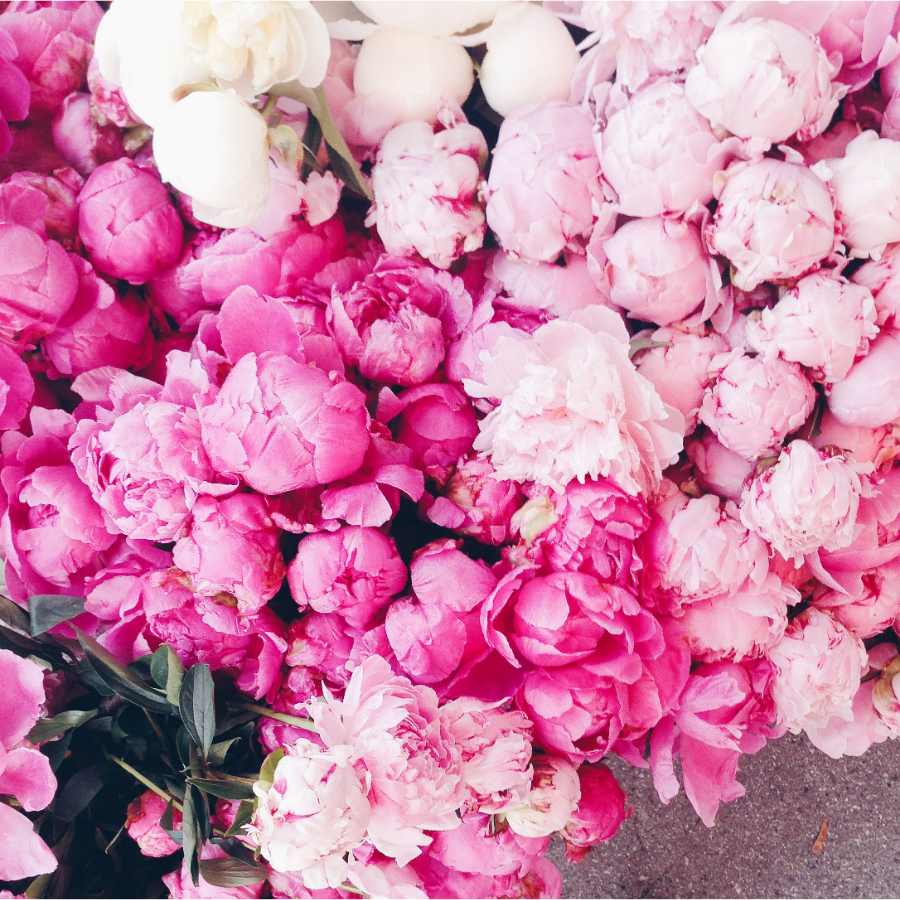Basic Flower Care Principles: An introductory Guide

Receiving a beautiful bouquet of fresh flowers is always a delight, whether it's for a special occasion or simply to brighten up your home. However, without proper care and handling, those stunning blooms can quickly wilt and fade. By following some basic flower care principles, you can significantly extend the lifespan of your cut flowers and ensure they remain vibrant and beautiful for as long as possible.
In this introductory guide, one of many in our flower care series, we'll cover the essential tips and techniques for keeping your cut flowers looking their best. From selecting the right blooms to providing optimal water, nutrients, and environmental conditions, these fundamental principles will help you become a pro at flower care.
Some key aspects we'll discuss include in this blog post:
- Choosing healthy, high-quality flowers
- Properly preparing stems for maximum water uptake
- Using clean vases and fresh water
- Providing the right balance of nutrients with flower food
- Maintaining optimal temperature, humidity, and light conditions
- Regularly trimming stems and removing dead foliage
- Protecting flowers from ethylene gas and other damaging factors
Whether you're a flower enthusiast, a budding florist, or simply someone who enjoys having fresh blooms around the house, understanding these basic flower care principles is essential. By investing a little time and effort into properly caring for your cut flowers, you'll be rewarded with longer-lasting, more vibrant arrangements that bring joy and beauty to your space.
Understanding the nuances of flower care is a testament to the quality and service that Lily's Florist upholds, ensuring that every bouquet delivered is not only a visual treat but also a lasting symbol of affection and thoughtfulness. As we jump into these essential flower care tips, we're not only enhancing the longevity of these beautiful blooms but also enriching the experience of every Lily's Florist customer, reaffirming their choice in a florist that goes beyond mere delivery to offer a comprehensive guide to making the most of their floral arrangements. This attention to detail and commitment to customer satisfaction is what sets Lily's Florist apart, making it a trusted partner in celebrating life's special moments with flowers that are cared for, cherished, and remembered.
Here are our best selling flowers over the last 12 months:
Selecting and Buying Cut Flowers
Choosing the right cut flowers is essential for ensuring they stay fresh and beautiful for as long as possible. When buying flowers, look for blooms that are vibrant in color with firm petals and buds that are just starting to open. Avoid flowers with brown spots, transparent or wilting petals, and discoloration, as these are signs the flowers are past their prime.
Pay close attention to the stems and leaves when selecting your bouquet. Look for:
- Firm, sturdy stems that are green and smooth, not slimy or broken
- Healthy, green leaves that are not yellowing, brown, or wilted
- Stems that are cut evenly with no fraying or discoloration
If buying roses, gently squeeze the point where the petals meet the stem. Fresh roses will feel firm, while older blooms will be soft and spongy. When choosing flower buds, opt for those that are slightly open, as they will continue to bloom in the vase, extending the life of your arrangement.
Consider the seasonality of the flowers you select. Buying blooms that are in season not only ensures the freshest flowers but also often means a lower price point. Talk to your florist about what varieties are currently at their peak.
When possible, purchase your cut flowers from a reputable online florist like Lily's Florist or flower market. This allows you to inspect the blooms in person and select the freshest stems.
Finally, don't be afraid to ask your florist for recommendations based on your preferences, budget, and the occasion. They have the expertise to guide you towards the best flower choices and can create a custom arrangement that perfectly suits your needs.
Preparing Flowers for the Vase
Once you've selected your beautiful cut flowers, it's time to prepare them for their new home in a vase. Proper preparation is key to ensuring your blooms stay fresh and vibrant for as long as possible.
- Start by filling your vase with clean, room temperature water. If your flowers came with a packet of flower food, follow the instructions on the package and mix it into the water. This specialized blend of nutrients and preservatives helps nourish the flowers and prevent bacterial growth.
- Next, remove any leaves that will fall below the water line in the vase. Leaving foliage submerged can cause bacteria to develop, leading to cloudy water and shorter flower life. If your flowers have thorns, like roses, you may want to remove them with a thorn stripper or carefully with scissors to avoid injury.
- Using a sharp, clean knife or shears, trim 1-2 inches off the bottom of each stem at a 45-degree angle. This angled cut allows for better water absorption and prevents the stem from resting flat against the bottom of the vase, which can hinder water uptake. Make sure to cut the stems under running water or submerged in a bowl of water to prevent air bubbles from forming in the stem and blocking water flow.
For some flowers with woody or fibrous stems, like lilacs or chrysanthemums, you may need to split the bottom inch of the stem vertically to encourage better water absorption. Flowers with bulbous stems, such as daffodils and amaryllis, benefit from having their hollow stems filled with water before placing them in the vase.
If you're creating a mixed arrangement, consider the varying heights and textures of your flowers. Start by placing the largest, most dominant blooms first, then fill in with smaller, more delicate flowers and greenery. This creates a balanced, visually appealing display.
Flower Food and Preservatives

One of the most effective ways to extend the life of your cut flowers is by using flower food and preservatives. These specially formulated products provide essential nutrients, help prevent bacterial growth, and keep your blooms looking fresh and vibrant for longer.
Commercial flower food packets typically contain a mix of ingredients such as:
- Sugar: Provides energy for the flowers to continue opening and maintain their vibrant colors.
- Acidifiers: Help lower the pH of the water, allowing for better water uptake and flow through the stems.
- Biocides: Prevent the growth of harmful bacteria and fungi that can cause the water to become cloudy and foul-smelling.
When using store-bought flower food, be sure to follow the instructions on the package carefully. Mix the powder into room temperature water before adding your flowers, and change the water and re-cut the stems every few days to ensure your blooms are receiving fresh nutrients.
If you don't have access to commercial flower food, you can create a simple homemade preservative using ingredients found in your kitchen. A common recipe includes:
- 1 teaspoon of sugar
- 1 teaspoon of bleach
- 2 teaspoons of lemon juice or white vinegar
- 1 quart of lukewarm water
The sugar nourishes the flowers, while the bleach helps control bacteria, and the lemon juice or vinegar lowers the pH of the water for better absorption.
In addition to flower food, there are other preservatives you can use to help extend the life of your cut flowers. Some florists recommend adding a small amount of vodka or clear soda to the water, as the alcohol can help inhibit bacterial growth and the sugar provides energy for the blooms.
Another popular preservative is copper coins. Dropping a clean penny into the vase can help reduce bacteria and fungi growth, as copper has natural antimicrobial properties. However, the effectiveness of this method is debated, and it's best used in conjunction with other flower care techniques.
Regardless of which preservatives you choose, remember that the key to keeping your cut flowers looking their best is to change the water regularly, re-cut the stems, and remove any dead or wilting foliage. By providing your blooms with the right nutrients and care, you'll be able to enjoy their beauty for days or even weeks to come.
Optimal Environmental Conditions
In addition to providing your cut flowers with the right nutrients and care, it's essential to create the optimal environment for them to thrive. By controlling factors such as temperature, humidity, and light, you can significantly extend the life of your blooms and keep them looking their best.
Temperature
One of the most important environmental factors to consider is temperature. Most cut flowers prefer cool temperatures between 65-72°F (18-22°C) and can quickly wilt or fade in excessive heat. To keep your flowers fresh, display them away from direct sunlight, heating vents, and drafty areas like open windows or air conditioning units. If your home tends to be warm, consider placing your vase in a cooler room or even in the refrigerator overnight to help prolong the life of your blooms.
Humidity
Humidity is another crucial factor in maintaining the health of your cut flowers. Many blooms, particularly tropical varieties, thrive in high humidity environments. If your home has dry air, you can increase the humidity around your flowers by placing the vase on a pebble tray filled with water or misting the blooms lightly with water each day. Just be sure not to overdo it, as excessive moisture can lead to mold growth and cause the flowers to decay prematurely.
Light
When it comes to light, most cut flowers prefer bright, indirect sunlight. While some blooms, like sunflowers and daisies, can tolerate more direct light, others, such as roses and lilies, can quickly fade or wilt when exposed to too much sun. If you're unsure about the light preferences of your specific flowers, ask your florist for guidance or consult online care guides.
Other Factors
Another environmental factor to be aware of is ethylene gas, a natural plant hormone that can cause flowers to age and wilt prematurely. Some fruits, such as apples, bananas, and avocados, release ethylene gas as they ripen, so it's best to keep your cut flowers away from fruit bowls or baskets. Cigarette smoke and car exhaust can also contain ethylene, so avoid displaying your flowers near smoking areas or busy roads.

Special Considerations for Different Flower Types
While the basic principles of flower care apply to most cut flowers, certain varieties may require special attention or specific techniques to help them look their best and last longer. By understanding the unique needs of different flower types, you can provide targeted care and ensure your blooms remain vibrant and beautiful for as long as possible.
One important consideration for many cut flowers is the hardening process, which involves conditioning the stems to maximize water uptake and prevent wilting. For flowers like roses, carnations, and chrysanthemums, this typically involves submerging the stems in warm water (around 100°F or 38°C) for 30 minutes to an hour before arranging them in a vase. This helps open up the stem's capillaries and allows the flowers to absorb water more efficiently.
Other flowers, such as daffodils and tulips, have specific requirements for vase water to ensure their longevity. Daffodils, for example, release a sap that can be harmful to other flowers, so it's best to display them separately or condition their stems in a separate vase for a few hours before adding them to a mixed arrangement. Tulips, on the other hand, are sensitive to ethylene gas and should be kept away from fruits and vegetables that emit this ripening agent.
When it comes to popular summer blooms like sunflowers, zinnias, and dahlias, it's important to pay extra attention to their water needs, as they tend to be thirstier than other flowers. Be sure to check the water level in your vase daily and top it off as needed to keep these sun-loving flowers hydrated and happy.
For delicate blooms like peonies, anemones, and ranunculus, handle the stems gently to avoid bruising or damaging the petals. These flowers also benefit from a little extra support in the vase, so consider using a flower frog or grid to help them stand upright and maintain their shape.

If you're working with woody stems like lilacs, dogwood, or cherry blossoms, you may need to split the bottom inch of the stem vertically to encourage better water absorption. Alternatively, you can use a hammer to gently crush the bottom of the stem, which helps break down the tough fibers and allows the flower to drink more easily.
Finally, for long-lasting evergreen foliage like eucalyptus, magnolia leaves, and holly, be sure to remove any leaves that will fall below the water line in your vase. These leaves can quickly become slimy and release bacteria into the water, shortening the life of your arrangement.
Seeds Of Wisdom
In this comprehensive guide, we've explored the essential principles of flower care and discovered how to keep your cut flowers looking fresh, vibrant, and beautiful for as long as possible. From selecting the highest quality blooms to providing the optimal water, nutrients, and environmental conditions, these techniques will help you create stunning, long-lasting floral arrangements that brighten up any space.
To recap, the key elements of proper flower care include:
- Choosing healthy, vibrant flowers with firm stems and buds
- Preparing your vase with clean water and the appropriate flower food or preservatives
- Trimming the stems at an angle and removing any foliage below the water line
- Displaying your flowers in a cool, humid environment away from direct sunlight, drafts, and ripening fruits
- Regularly changing the water, re-cutting the stems, and removing any dead or wilted plant material
- Providing targeted care for specific flower varieties based on their unique needs and requirements
By incorporating these practices into your flower care routine, you'll be able to extend the lifespan of your cut flowers and enjoy their natural beauty for days or even weeks to come. Whether you're a seasoned floral enthusiast or a beginner looking to learn the basics, these principles will help you create stunning, long-lasting arrangements that impress and delight.
So the next time you bring home a beautiful bouquet or receive a lovely floral gift, remember these essential flower care tips and put them into practice. With a little time, attention, and care, you can keep your blooms looking their best and create a warm, inviting atmosphere in any room.
Embrace the joy and beauty of fresh flowers, and share your newfound knowledge with others who appreciate the simple pleasure of a well-cared-for arrangement. By mastering these basic flower care principles, you'll be able to create stunning displays that showcase the natural elegance and charm of cut flowers, no matter the occasion or setting.
Frequently Asked Questions
- How can I revive wilted flowers? If your cut flowers are looking a bit droopy, don't despair! There are several ways to perk them back up. First, try re-cutting the stems at a 45-degree angle under running water and placing them in fresh, clean water with flower food. You can also try submerging the entire flower, head and all, in cool water for 30 minutes to an hour to help rehydrate the petals. If your blooms are still looking sad, you may need to remove any dead or damaged foliage and consider using a floral preservative to help them bounce back.
- Can aspirin or pennies help extend the life of cut flowers? While there are many home remedies that claim to extend the life of cut flowers, such as adding aspirin, pennies, or even vodka to the vase water, the effectiveness of these methods is largely anecdotal. Aspirin, which contains salicylic acid, may help lower the pH of the water and improve water uptake, but it can also cause the water to become cloudy and foul-smelling. Pennies, which contain copper, are thought to have antimicrobial properties that can help prevent bacterial growth, but the effect is likely minimal. Ultimately, the best way to extend the life of your flowers is to use a commercial flower food or a homemade preservative made with sugar, bleach, and lemon juice or vinegar.
- How long can I expect my cut flowers to last with proper care? The lifespan of cut flowers can vary widely depending on the specific variety, the quality of the blooms, and the care they receive. On average, most flowers can last anywhere from 5-14 days with proper care, although some hardy varieties like carnations and chrysanthemums can last even longer. To maximize the lifespan of your flowers, be sure to follow the essential flower care principles outlined in this guide, including regular water changes, stem trimming, and the use of flower preservatives. By providing your blooms with the optimal conditions and care, you can enjoy their beauty for as long as possible.
- How often should I change the water in my flower vase? To keep your cut flowers looking fresh and healthy, it's important to change the water in your vase every 2-3 days, or sooner if the water becomes cloudy or foul-smelling. When changing the water, be sure to clean the vase thoroughly with soap and water to remove any built-up bacteria or debris. You should also re-cut the stems of your flowers at a 45-degree angle and remove any dead or wilted foliage to help prevent bacterial growth and improve water uptake. By refreshing the water and providing your blooms with a clean, nutrient-rich environment, you can help extend their lifespan and keep them looking beautiful for days to come.
